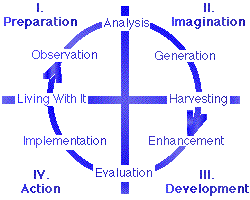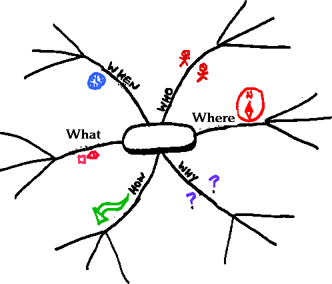Creativity
What is the creative process?
There are numerous models, but they have several underlying themes (see http://www.directedcreativity.com/pages/WPModels.html):
- The creative process involves purposeful analysis, imaginative idea generation, and critical evaluation -- the total creative process is a balance of imagination and analysis.
- Older models tend to imply that creative ideas result from subconscious processes, largely outside the control of the thinker. Modern models tend to imply purposeful generation of new ideas, under the direct control of the thinker.
- The total creative process requires a drive to action and the implementation of ideas. We must do more than simply imagine new things, we must work to make them concrete realities.

This model incorporates many earlier models, showing how preparation, imagination, development and action are all essential parts of a creativity "cycle" that starts and ends with real life.
Can you make yourself be more creative?
Most sources agree that we all have the ability to be creative. Here are some of the more enlightening ones.
- 6 Myths of Creativity - The corporate environment imposes limitations on creativity with these myths:
- Creativity comes from creative types.
- Money is a creativity motivator.
- Time pressure fuels creativity.
- Fear forces breakthroughs.
- Competition beats collaboration.
- A streamlined organization is a creative organization.

- 10 Creativity Kickstarts from Creativity Web - Here are some strategies for coming up with innovative ideas:
- Journaling - write 3 pages every day about something.
- Regular fresh input - expose yourself to new ideas, music, locations, etc.
- Carry your journal with you - and use it!
- Learn a new creativity technique each week.
- Relax!
- Learn to draw
- Learn to mind map - to take notes, and generate ideas by association.
- Associational thinking - with free word associations.
- Be challenged - frequently give yourself fresh problems to work on.
- Adopt a genius - learn how other creative people got their ideas.
- Creativity, Innovation, and Problem Solving - Here are some guidelines for making yourself more creative. Notice how similar this is to task-centered design.
(And take a look at the examples of creativity on the web site!)
- Understand your customer or end user.
- Ask the right question: what is the problem?
- Use proper tools and procedures.
- Get good ideas from everyone, everywhere.
- Keep your eyes open for serendipity.
- Search for multiple solutions.
- Brainstorm.
- Experiment, play, exaggerate, and persist.
- Take good notes!
- 4 Ways to Sidestep Creativity Blocks - If you get stuck, you can try these strategies. Can you think of others?
- Take a walk, ride a bike, or hike a trail.
- Change your perspective by working on the floor.
- Get out of the office/lab.
- Go for a drive.


